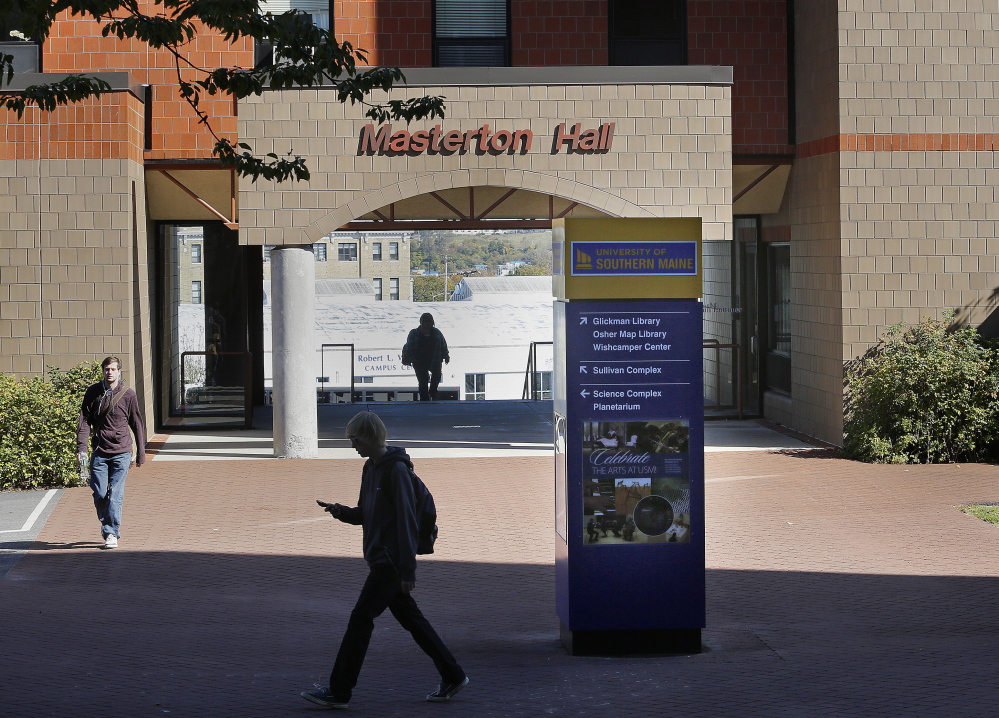Budget cuts proposed by University of Southern Maine officials would result in fewer faculty teaching more courses, and a corresponding loss of research, community service and the ability to retain and attract quality professors, some faculty members say.
The blueprint announced by the administration on Monday for a leaner, more cost-effective university that is better able to meet its expenses would entail reducing the number of full-time faculty by 50 positions – to start.
The plan proposed by USM President David Flanagan also would require full-time faculty to teach four courses each semester, learn to teach online courses and spend four days a week on campus.
The new expectation that all faculty teach four courses a semester would be particularly difficult in some departments such as English, with regular papers from students needing review and feedback, English Department Chair Jane Kuenz said.
“If you go to (four courses a semester) you are not going to have a research facility,” Kuenz said. “This undermines what a university is. … It’s a black eye on the university.”
She believes the cuts also would make it harder for USM to attract quality faculty, and could hurt student recruitment. Some talented faculty members already have left, she said.
“It’s a real selling point (for students) to come to USM and have most of your classes with under 30 students with a Ph.D. who publishes,” she said. “It may be that Flanagan, who’s from outside the university, may not understand this.”
Faculty members said Monday that they already consistently work more than 40 hours a week and sometimes much more, depending on the time spent grading papers, holding office hours and participating in meetings.
“We could only hope it would be a 9-to-5 job,” said Paul Christiansen, a music professor whose job could be eliminated. He said working 60 to 80 hours a week is not unheard of, and requiring four courses a semester could make it hard to recruit faculty.
Joseph McDonnell, provost and vice president of academic affairs, said that budget shortfalls throughout the University of Maine system mean faculty will have to make changes, although not all will see an increase in their workload.
“Many faculty are teaching many students, doing scholarship and have extraordinary service activities both to the university and to the public. … We’re seeking to bring the rest of them up to their level,” he said. Some faculty will focus more on research or community service, while others will teach more courses with more students, he said.
McDonnell expects that a typical faculty member with research and community service commitments might teach seven courses over a year.
The increased emphasis on teaching mirrors a national trend in public universities to set minimum workloads for faculty, at the same time higher education appropriations in most states have failed to keep pace with costs. That has led, in most states, to tuition increases and budget battles.
The number of courses full-time faculty teach per year at public universities varies depending on the academic discipline and expectations for research, publishing and teaching.
The American Association of University Professors recommends faculty teach nine hours a week in the classroom for undergraduates, the equivalent of three classes a semester. It recommends six hours, or two classes, for graduate courses.
The association says the undergraduate maximum should be 12 hours per week, or four classes per semester, with no more than six different courses taught in a year, to cut down on class preparation time. For graduate courses, the maximum would be three classes per semester.
Teaching 12 hours a week requires many more hours than what is spent in the classroom, said Susan Feiner, an economics professor at USM. Faculty must prepare lectures, design and correct tests, edit papers, provide extra help, advise students and stay abreast of research. An analysis by anthropologist John Ziker at Boise State University found that faculty there typically work about 60 hours per week during the school year and spend about one third of their time teaching.
Paul Nakroshis, a physics professor who started teaching at USM in 1997, said he recently gave a test in his introductory physics class to 100 students. It included six pages of questions with multiple parts. Grading them all and giving each student feedback on just the one test took him an entire week.
Nakroshis said if he spends more time teaching large classes, he won’t be able to spend as much time in the lab with students. At the University of Maine’s flagship campus in Orono, a physics professor teaches three courses a year and has teaching assistants to lead small group discussions and correct tests, he said.
Not all faculty say they have a problem teaching four courses a semester. Eileen Eagan, a USM history professor, said that workload would not seem unreasonable at Southern Maine Community College, which has little expectation of research and publishing.
“I was hired to teach four classes,” said Eagan. “For some of the departments at USM, four classes is not a weird thing.”
Send questions/comments to the editors.



Success. Please wait for the page to reload. If the page does not reload within 5 seconds, please refresh the page.
Enter your email and password to access comments.
Hi, to comment on stories you must . This profile is in addition to your subscription and website login.
Already have a commenting profile? .
Invalid username/password.
Please check your email to confirm and complete your registration.
Only subscribers are eligible to post comments. Please subscribe or login first for digital access. Here’s why.
Use the form below to reset your password. When you've submitted your account email, we will send an email with a reset code.